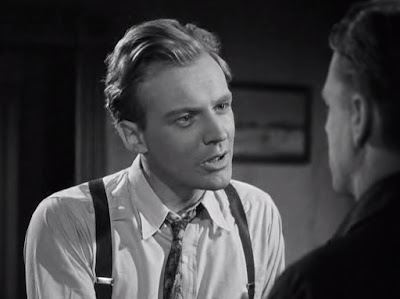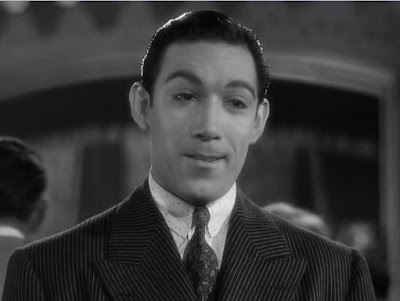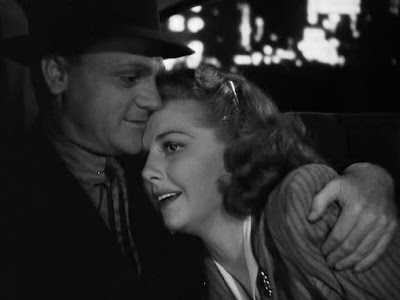directed by William Wyler, starring Terence Stamp, Samantha Eggar
(Note: This is my entry for the The Best Hitchcock Movies (That Hitchcock Never Made) Blogathon, hosted by Dorian from Tales of the Easily Distracted and Becky from ClassicBecky's Brain Food)
This is the tale of Miranda Grey, the art student, (Samantha Eggar) and Freddie Clegg (Terence Stamp), the butterfly collector. She's beautiful, ambitious, and naive. Freddie is shy, poor, and utterly obsessed with her. When Freddie wins a fortune in the football pools, he devises the perfect use for his newfound wealth. He buys a remote house and converts the basement into a comfortable prison for Miranda. He furnishes it with everything she could possibly want: art supplies, books, clothes, and cosmetics. Surely if he brings her here and keeps her for awhile, she will learn to love him. Freddie follows through by chloroforming Miranda and dragging her to the basement. When Miranda wakes she discovers, not a brave new world, but a strange, servile man. He apologizes for the use of force, promises to respect her boundaries, but refuses to let her go. Baffled and angry, Miranda soon realizes that escape won't be easy. She strikes a bargain with Freddie, promising to stay a month. At the end of a month, he must let her go. Freddie agrees, confident that she will soon love him. But Miranda's imprisonment will end up changing them both, in strange and brutal ways.
The Collector, based on John Fowles' novel, came to the screen in 1965, during the last years of the studio era. Standards had started to loosen up though, and this darkly twisted tale, which surely would have given Mayer or Goldwyn heart palpitations, was kept faithful to the book, right up to the diabolical ending. William Wyler turned down The Sound of Music to make this film, intrigued by the subject matter. It was really the first proper suspense thriller he'd ever done.
Comparing this film to Wyler's others give it an interest factor beyond the original story. Wyler had tackled dark obsession and villainy before (The Letter, The Little Foxes) but this was more visceral and explicitly sexual. Now, the distinctive mood in a Wyler film is compassion, but at a distance. He will bring you close to characters and then let the camera stand back, as we helplessly watch them suffer, love, self-destruct, or redeem themselves. Wyler invites sympathy for these people and yet there's a conscious restraint, as if he's allowing us to only see so much. So you take that Wyler quality and then look at The Collector. For example, in a scene where Miranda and Freddie struggle in the rain, Wyler holds the camera back from them, letting us see their fight as if from far away, as if we were witnesses to a crime. Then the camera goes down low and we see the tactile reality of the fight, their bodies slipping on the wet grass, the blood mixing in with the rain. The camera is at that same low angle when they return to the basement, Miranda's body flung brutally on the floor. The two gasp for breath, exhausted from the effort and because we are kept so close to them, we can feel it as if we were part of it. Anyone who wants to accuse Wyler of being staid should take a look at that moment again.
When I think about a word to describe Terence Stamp, the first one that always comes to mind is "presence." The man just has remarkable confidence onscreen and he had it right from the beginning. Billy Budd was his screen debut. Stamp took the role of a young man whose sensual beauty and angelic goodness is enough to drive men to destruction and tragedy. And he portrayed it so completely that I can't imagine any other actor in the part.
The Collector was his third film and it's almost a photo-negative reversal of Billy Budd. Instead of a pure-hearted Christ figure, he's a cold, kidnapping psychopath. Instead of being the object of desire, he's a prudish, probably-impotent loner who obsesses over a woman he can't have. Where Billy is the innocent center in a chaotic world, Freddie is that chaos unleashed. That Stamp was able to take two such disparate roles at the beginning of his career and inhabit them, with no self-consciousness, is amazing. Try as I might, I never catch the man trying to protect himself. As Billy, the otherworldly ideal, Stamp offers himself up for the camera's gaze in a way that makes the villain's obsession with him clear. But for the role of Freddie, Stamp closes himself up, shutting out any hint of charm, slyness, or campy appeal. It's as deliberately uncharismatic a villain as you can get.
In the annals of cinematic psychopaths, you'd think Freddie Clegg would have a thriving fanbase. I mean, he's lonely, despised, romantic, and kidnaps a woman to make her love him. Surely, the fans who obsess over the Phantom of the Opera and Frollo would adore this guy. But nope, in spite of a fewYoutubevideos. While that can partly be attributed to the relative obscurity of this film, I think it has a lot to do with Stamp's performance. He's awkward onscreen, in a way that evokes discomfort rather than sympathy. He wears his suits like the coat hanger was still inside. His gaze is flat, even when professing love. We've all met people who gave off that same unnerving dissonance. These are the people we move away from on the subway, the people we look away from even if we don't know why. Stamp's performance gives the film that extra shudder of plausibility.
Now prior to this film, the only Samantha Eggar film I knew was Doctor Dolittle, in which she's about as obligatory a female character as you can get. In the scenes where Eggar has to regard Rex Harrison with romantic yearning, Eggar mostly looks puzzled or irritated by turn (which, knowing what an utter debacle the making of that film was, you can hardly blame her). But in The Collector, Eggar is wonderful, taking the naive but resourceful Miranda and making her someone to root for. She's so innocently pretentious at times that you cringe for her (for example, telling Freddie that his obsession is "the kind of dream young boys have once they hit puberty"), but underneath it, you can see a woman fighting tooth and nail to keep her sense of self. When Eggar crumples to the ground at one point, sobbing, "Let me be free," your heart truly aches for her. Actually, considering all that Eggar has to undergo in this film, from nude shots to violent struggles with Stamp, I did wonder if Cronenberg saw The Collector and thought, "Now how could I torture this woman more?"
The worst flaw in The Collector is Maurice Jarre's harpsichord-driven, aggressively-quirky score. Now, readers of my blog might point out that I just finished trashing the music in Wyler's Friendly Persuasion. But that film's music was just sentimental. The Collector score on the other hand, is downright horrible, knocking the mood askew in nearly every scene. It's tinkly, dischordant, and whimsical. Inviting whimsy into your tale of dark romantic obsession is like inviting Christopher Walken into Ophelia's mad scene. I was happy to find out that the author John Fowles was on my side about the music, saying, "Surely silence would be better."
Now, when I listed The Collector among my "fascination films," I also put Hitchock's Marnie on that list. And when you think of it, these two films are close cinematic cousins. Released with a year of each other, they both tell the story of men who wish to posses women, whatever the cost. When Sean Connery mockingly talks about his interest in taming wildlife to Tippi Hedren, it's hard not to think of Terence Stamp showing his butterfly collection to Samantha Eggar, saying, "What difference does one specimen make to a whole species?" But where Marnie was lurid, messy, and deeply personal, The Collector is polished, cool, and cerebral. While certain scenes in The Collector feel like they could have come straight out of the Hitchcock playbook (for example, a moment where Miranda tries to alert an oblivious neighbor by overflowing the bathtub), the overall mood is entirely different. Wyler's matter-of-fact approach to The Collector is both a strength and a weakness. It makes the film consistently uncomfortable to watch; Wyler refuses to make moral judgments or tell us what to think. But at the same time, while The Collector has ample chills and surprises, it's never obsessive or romantic in the way that Marnie was.
And yet I keep coming back to The Collector. Its characters, its direction, its strange, steady-handed storytelling. And the look in Terence Stamp's eyes when his last vestige of sanity snaps and he tells Miranda, "I can do what I like!"
Favorite Quote:
"Marry me. Please marry me. I don't expect anything. I don't expect you to do anything you don't want. You can do what you like...study art...I won't ask anything. Anything of you. Except you live in the same house and be my wife in name. You can have your own bedroom. You can lock it every night."
Favorite Scene:
For me, the film crystallizes in a single perfect scene where Miranda and Freddie discuss The Catcher in the Rye. Freddie's frustration with Miranda and her "la-dee-da" ways has begun to boil over. Angry at what he considers her class superiority, he insists on reading her favorite book and finding out why she thinks it special. When he returns, he tells her flatly that he didn't see much point in it. Miranda tries haltingly to explain, describing her love for Holden Caulfield's character. "The boy, he's so aware...the way he hates everything that's false." Freddie responds, "He sounds a mess to me." The tension builds unbearably as Freddie grows angrier and the increasingly terrified Miranda blunders on. Finally, frustrated with Freddie's determined incomprehension of the book, she snaps, "You don't understand, you're not trying to see how much like... like all of us he is." Freddie immediately knows the meaning of her stumble and says icily, "Like me? That's what you meant, isn't it?" And he's right.
It's a brilliant moment that turns over our expectations as well as Miranda's. Because we might have believed, as Miranda does, that this awkward loner will gravitate to Holden Caulfield, but when Freddie turns the tables on her, it makes perfect sense. Of course this man, with his suits and class consciousness and "proper respect" would think that Caulfield was a spoiled whiner. On top of that, the scene just works perfectly as the moment in which we can see Freddie finally tipping over the edge into murderous rage, as Miranda tries frantically to say or do the right thing. But there is no right thing. She's alone with a madman. And this time, he's got her pegged.
Final Six Words:
Cold and clammy tale of obsession
(Note: This is my entry for the The Best Hitchcock Movies (That Hitchcock Never Made) Blogathon, hosted by Dorian from Tales of the Easily Distracted and Becky from ClassicBecky's Brain Food)
This is the tale of Miranda Grey, the art student, (Samantha Eggar) and Freddie Clegg (Terence Stamp), the butterfly collector. She's beautiful, ambitious, and naive. Freddie is shy, poor, and utterly obsessed with her. When Freddie wins a fortune in the football pools, he devises the perfect use for his newfound wealth. He buys a remote house and converts the basement into a comfortable prison for Miranda. He furnishes it with everything she could possibly want: art supplies, books, clothes, and cosmetics. Surely if he brings her here and keeps her for awhile, she will learn to love him. Freddie follows through by chloroforming Miranda and dragging her to the basement. When Miranda wakes she discovers, not a brave new world, but a strange, servile man. He apologizes for the use of force, promises to respect her boundaries, but refuses to let her go. Baffled and angry, Miranda soon realizes that escape won't be easy. She strikes a bargain with Freddie, promising to stay a month. At the end of a month, he must let her go. Freddie agrees, confident that she will soon love him. But Miranda's imprisonment will end up changing them both, in strange and brutal ways.
The Collector, based on John Fowles' novel, came to the screen in 1965, during the last years of the studio era. Standards had started to loosen up though, and this darkly twisted tale, which surely would have given Mayer or Goldwyn heart palpitations, was kept faithful to the book, right up to the diabolical ending. William Wyler turned down The Sound of Music to make this film, intrigued by the subject matter. It was really the first proper suspense thriller he'd ever done.
Comparing this film to Wyler's others give it an interest factor beyond the original story. Wyler had tackled dark obsession and villainy before (The Letter, The Little Foxes) but this was more visceral and explicitly sexual. Now, the distinctive mood in a Wyler film is compassion, but at a distance. He will bring you close to characters and then let the camera stand back, as we helplessly watch them suffer, love, self-destruct, or redeem themselves. Wyler invites sympathy for these people and yet there's a conscious restraint, as if he's allowing us to only see so much. So you take that Wyler quality and then look at The Collector. For example, in a scene where Miranda and Freddie struggle in the rain, Wyler holds the camera back from them, letting us see their fight as if from far away, as if we were witnesses to a crime. Then the camera goes down low and we see the tactile reality of the fight, their bodies slipping on the wet grass, the blood mixing in with the rain. The camera is at that same low angle when they return to the basement, Miranda's body flung brutally on the floor. The two gasp for breath, exhausted from the effort and because we are kept so close to them, we can feel it as if we were part of it. Anyone who wants to accuse Wyler of being staid should take a look at that moment again.
When I think about a word to describe Terence Stamp, the first one that always comes to mind is "presence." The man just has remarkable confidence onscreen and he had it right from the beginning. Billy Budd was his screen debut. Stamp took the role of a young man whose sensual beauty and angelic goodness is enough to drive men to destruction and tragedy. And he portrayed it so completely that I can't imagine any other actor in the part.
The Collector was his third film and it's almost a photo-negative reversal of Billy Budd. Instead of a pure-hearted Christ figure, he's a cold, kidnapping psychopath. Instead of being the object of desire, he's a prudish, probably-impotent loner who obsesses over a woman he can't have. Where Billy is the innocent center in a chaotic world, Freddie is that chaos unleashed. That Stamp was able to take two such disparate roles at the beginning of his career and inhabit them, with no self-consciousness, is amazing. Try as I might, I never catch the man trying to protect himself. As Billy, the otherworldly ideal, Stamp offers himself up for the camera's gaze in a way that makes the villain's obsession with him clear. But for the role of Freddie, Stamp closes himself up, shutting out any hint of charm, slyness, or campy appeal. It's as deliberately uncharismatic a villain as you can get.
In the annals of cinematic psychopaths, you'd think Freddie Clegg would have a thriving fanbase. I mean, he's lonely, despised, romantic, and kidnaps a woman to make her love him. Surely, the fans who obsess over the Phantom of the Opera and Frollo would adore this guy. But nope, in spite of a fewYoutubevideos. While that can partly be attributed to the relative obscurity of this film, I think it has a lot to do with Stamp's performance. He's awkward onscreen, in a way that evokes discomfort rather than sympathy. He wears his suits like the coat hanger was still inside. His gaze is flat, even when professing love. We've all met people who gave off that same unnerving dissonance. These are the people we move away from on the subway, the people we look away from even if we don't know why. Stamp's performance gives the film that extra shudder of plausibility.
Now prior to this film, the only Samantha Eggar film I knew was Doctor Dolittle, in which she's about as obligatory a female character as you can get. In the scenes where Eggar has to regard Rex Harrison with romantic yearning, Eggar mostly looks puzzled or irritated by turn (which, knowing what an utter debacle the making of that film was, you can hardly blame her). But in The Collector, Eggar is wonderful, taking the naive but resourceful Miranda and making her someone to root for. She's so innocently pretentious at times that you cringe for her (for example, telling Freddie that his obsession is "the kind of dream young boys have once they hit puberty"), but underneath it, you can see a woman fighting tooth and nail to keep her sense of self. When Eggar crumples to the ground at one point, sobbing, "Let me be free," your heart truly aches for her. Actually, considering all that Eggar has to undergo in this film, from nude shots to violent struggles with Stamp, I did wonder if Cronenberg saw The Collector and thought, "Now how could I torture this woman more?"
The worst flaw in The Collector is Maurice Jarre's harpsichord-driven, aggressively-quirky score. Now, readers of my blog might point out that I just finished trashing the music in Wyler's Friendly Persuasion. But that film's music was just sentimental. The Collector score on the other hand, is downright horrible, knocking the mood askew in nearly every scene. It's tinkly, dischordant, and whimsical. Inviting whimsy into your tale of dark romantic obsession is like inviting Christopher Walken into Ophelia's mad scene. I was happy to find out that the author John Fowles was on my side about the music, saying, "Surely silence would be better."
Now, when I listed The Collector among my "fascination films," I also put Hitchock's Marnie on that list. And when you think of it, these two films are close cinematic cousins. Released with a year of each other, they both tell the story of men who wish to posses women, whatever the cost. When Sean Connery mockingly talks about his interest in taming wildlife to Tippi Hedren, it's hard not to think of Terence Stamp showing his butterfly collection to Samantha Eggar, saying, "What difference does one specimen make to a whole species?" But where Marnie was lurid, messy, and deeply personal, The Collector is polished, cool, and cerebral. While certain scenes in The Collector feel like they could have come straight out of the Hitchcock playbook (for example, a moment where Miranda tries to alert an oblivious neighbor by overflowing the bathtub), the overall mood is entirely different. Wyler's matter-of-fact approach to The Collector is both a strength and a weakness. It makes the film consistently uncomfortable to watch; Wyler refuses to make moral judgments or tell us what to think. But at the same time, while The Collector has ample chills and surprises, it's never obsessive or romantic in the way that Marnie was.
And yet I keep coming back to The Collector. Its characters, its direction, its strange, steady-handed storytelling. And the look in Terence Stamp's eyes when his last vestige of sanity snaps and he tells Miranda, "I can do what I like!"
Favorite Quote:
"Marry me. Please marry me. I don't expect anything. I don't expect you to do anything you don't want. You can do what you like...study art...I won't ask anything. Anything of you. Except you live in the same house and be my wife in name. You can have your own bedroom. You can lock it every night."
Favorite Scene:
For me, the film crystallizes in a single perfect scene where Miranda and Freddie discuss The Catcher in the Rye. Freddie's frustration with Miranda and her "la-dee-da" ways has begun to boil over. Angry at what he considers her class superiority, he insists on reading her favorite book and finding out why she thinks it special. When he returns, he tells her flatly that he didn't see much point in it. Miranda tries haltingly to explain, describing her love for Holden Caulfield's character. "The boy, he's so aware...the way he hates everything that's false." Freddie responds, "He sounds a mess to me." The tension builds unbearably as Freddie grows angrier and the increasingly terrified Miranda blunders on. Finally, frustrated with Freddie's determined incomprehension of the book, she snaps, "You don't understand, you're not trying to see how much like... like all of us he is." Freddie immediately knows the meaning of her stumble and says icily, "Like me? That's what you meant, isn't it?" And he's right.
It's a brilliant moment that turns over our expectations as well as Miranda's. Because we might have believed, as Miranda does, that this awkward loner will gravitate to Holden Caulfield, but when Freddie turns the tables on her, it makes perfect sense. Of course this man, with his suits and class consciousness and "proper respect" would think that Caulfield was a spoiled whiner. On top of that, the scene just works perfectly as the moment in which we can see Freddie finally tipping over the edge into murderous rage, as Miranda tries frantically to say or do the right thing. But there is no right thing. She's alone with a madman. And this time, he's got her pegged.
Final Six Words:
Cold and clammy tale of obsession















_01.jpg)





_NRFPT_01.jpg)





_01.jpg)


















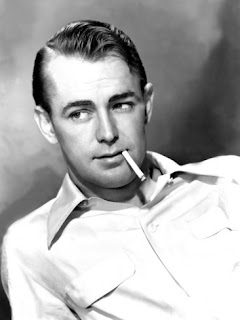





























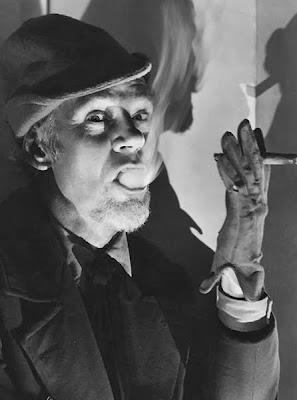






















_02.jpg)










